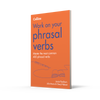Multi-word chunks of language, such as idioms and phrasal verbs, make up a large proportion of any written or spoken text, so they’re really key for learners to get to grips with. In the next two posts, I’ll be looking at updated editions of two resources that offer explanations and plenty of practice of the most frequent phrasal verbs and idioms in English: Work on Your Phrasal Verbs and Work on Your Idioms (both published September 2021).
Work on Your Phrasal Verbs: focusing on what we use most
Phrasal verbs can feel like an almost impossible challenge because so many different combinations seem to be possible. And they can’t be ignored because they’re so ubiquitous, with one estimate suggesting a learner will encounter a phrasal verb, on average, in every 150 words*. The good news is that a relatively small number of the most frequent combinations account for a large proportion of all usage, which is why Work on Your Phrasal Verbs focuses on the 400 most commonly used phrasal verbs.
For the new edition, we carried out fresh analysis using the Collins COBUILD corpus to check current usage and update the list of phrasal verbs from the first edition, published in 2012. This research led us to change almost 10% of the phrasal verbs we included, dropping some that had declined in use and adding some that had become more popular. Some of the changes reflect interesting shifts in our lifestyles.
🔽 call for/call in: These two phrasal verbs describe visiting someone at their home, often without arranging it in advance. They’ve declined in use perhaps because we’re now more likely to organize our social lives via our mobile phones. An exchange of messages means that we’re more likely to arrange a time and a place to …
🔼 meet up: Let’s meet up for a coffee.

🔽 write in: In the past, if we had a complaint or a request, we’d write in to an organization, sending an actual letter.
🔼 reach out: Nowadays, with multiple channels of communication (email, social media, instant messaging), we’re using more terms that don’t specify the exact medium, such as reach out (= contact someone to offer something or to ask for advice/information).
Actively using phrasal verbs:
If learners are to use phrasal verbs for themselves, they need to go beyond meaning to understanding how to use them in context. By redesigning the layout for the second edition of Work on Your Phrasal Verbs, we’ve freed up more space for practice activities that get learners not just matching the correct phrasal verb to a meaning but digging a bit deeper and more actively manipulating the language.
Collocations, or combinations of words that are typically used together, are an important part of developing fluency in all areas of language and no less so with phrasal verbs. Look at these examples from an activity in the unit on Discussions – can you match the noun objects to the highlighted phrasal verbs? [Answers at the end of the post].

As important as typical combinations of words are typical grammatical patterns, sometimes known as colligation. One matching activity in the unit on Thinking and Knowing highlights some phrasal verbs that are typically followed by -ing forms or wh- clauses.

Other activities look at:
- key prepositions that often follow phrasal verbs (e.g. you fall out with someone, but you fall out over something)
- whether objects can be used between the verb and the particle (e.g. if there’s a problem, you can say you will look into the matter, but you couldn’t say you will look the matter into)
And we’ve also added more activities that go beyond multiple choice and gap fills to encourage students to construct their own sentences using phrasal verbs. These work especially well in class where students can share their ideas and get feedback on what works and what doesn’t.
To find out more about the new edition of Work on Your Phrasal Verbs and see more of the activities which are designed for either self-study or classroom use, click here.
In my next post, I’ll look at some key considerations when learning and teaching idioms, and how we addressed these in the new edition of Work on Your Idioms.
[Collocations answers: go into details, agree with previous comments, back up their claim]
*Gardner, D. & Davies, M. (2007) Pointing Out Frequent Phrasal Verbs: A Corpus-Based Analysis, TESOL Quarterly, 41/2
